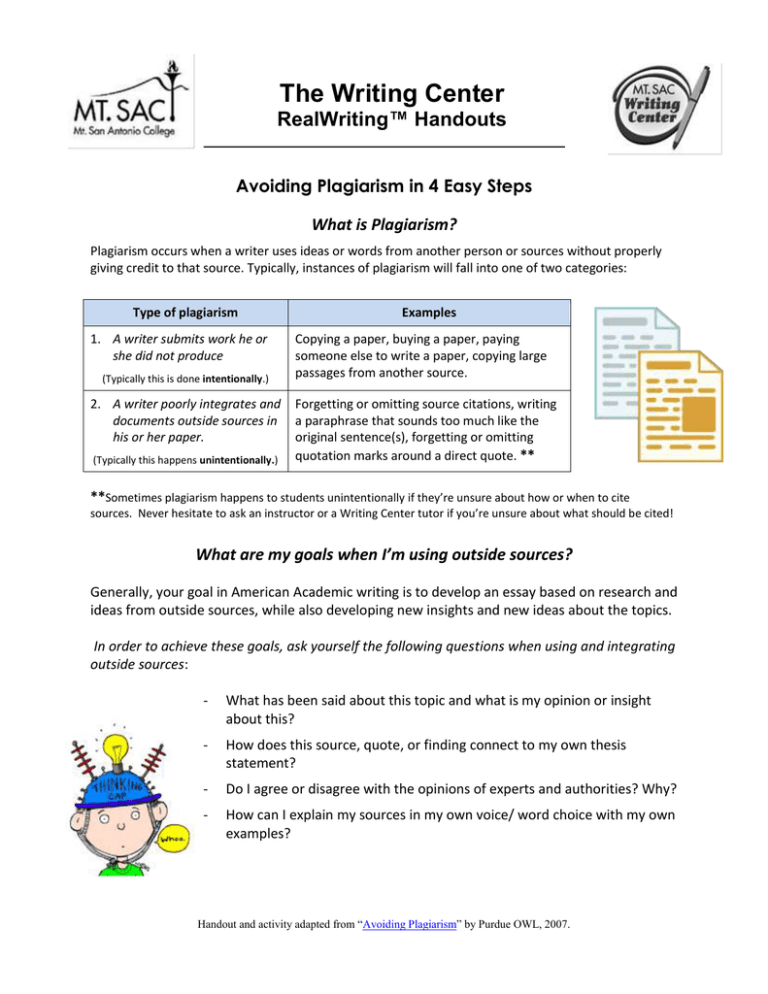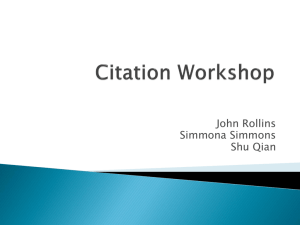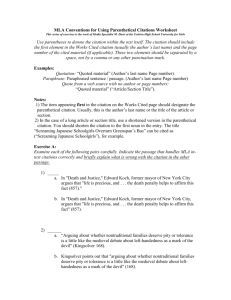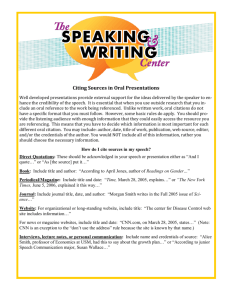The Writing Center RealWriting™ Handouts Avoiding Plagiarism in
advertisement

The Writing Center RealWriting™ Handouts Avoiding Plagiarism in 4 Easy Steps What is Plagiarism? Plagiarism occurs when a writer uses ideas or words from another person or sources without properly giving credit to that source. Typically, instances of plagiarism will fall into one of two categories: Type of plagiarism 1. A writer submits work he or she did not produce (Typically this is done intentionally.) 2. A writer poorly integrates and documents outside sources in his or her paper. (Typically this happens unintentionally.) Examples Copying a paper, buying a paper, paying someone else to write a paper, copying large passages from another source. Forgetting or omitting source citations, writing a paraphrase that sounds too much like the original sentence(s), forgetting or omitting quotation marks around a direct quote. ** **Sometimes plagiarism happens to students unintentionally if they’re unsure about how or when to cite sources. Never hesitate to ask an instructor or a Writing Center tutor if you’re unsure about what should be cited! What are my goals when I’m using outside sources? Generally, your goal in American Academic writing is to develop an essay based on research and ideas from outside sources, while also developing new insights and new ideas about the topics. In order to achieve these goals, ask yourself the following questions when using and integrating outside sources: - What has been said about this topic and what is my opinion or insight about this? - How does this source, quote, or finding connect to my own thesis statement? - Do I agree or disagree with the opinions of experts and authorities? Why? - How can I explain my sources in my own voice/ word choice with my own examples? Handout and activity adapted from “Avoiding Plagiarism” by Purdue OWL, 2007. How do I Avoid Plagiarism? 1. Take good notes! Whenever you’re doing research, it’s important to take notes so you can find and integrate these sources later in your essay. Develop a method to keep track of your own ideas and sources you find. Try some of the following options: - Note-taking Strategies Mark quotes with a big Q. Mark paraphrases or ideas from sources with a big S. - Mark your own insights, connections, or opinions with ME. - Include an internal citation** for all quotes or ideas from sources. - Write down all the documentation information, save the sources, or save the website link. - Tools & Resources Check out Noodle Bib on the Writing Center website. Noodle Bib is an online account that helps you take notes, keep track of sources, and develop citations. - Consider attending a Noodle Bib workshop at the Writing Center - Consider taking a Starting Your Research workshop at the Writing Center or a library workshop to develop some strategies for finding and using outside sources. **Internal citations typically include the author’s last name and the page number. For more on citations, see Purdue OWL or the Writing Center’s Integrating Sources and MLA In-text Citations handout. Additional links are available at the Writing Center website under “Online Resources for Student’s.” 2. Cite your sources. When writing your paper, it’s important that all of the following are cited with an internal citation: - Direct quotes (word-for-word phrases) from a source. - Any ideas, concepts, or opinions from a source that you explained in your own words (paraphrases & summaries**). - Any images, diagrams, charts, or audio/visual files that you found from another source. The insights, opinions, and analysis you develop in response to these sources do not need to be cited. Your personal experiences or observations also do not need to be cited. **For more practice, check out the Writing Center workshops and DLAs on summarizing and paraphrasing. 3. Signal quotes and paraphrases. Introducing your sources properly can also be an important way to alert yourself and your reader to where you’re using outside sources. Consider the following: - Identify the author or the title somewhere in the sentence when quoting, paraphrasing, or summarizing an outside source. - Put quotation marks around words or phrases that are the same as the original text. (If you’re struggling to rephrase a passage in your own words, consider just quoting it.) - Attend the Writing Center workshop, How to Quote and Paraphrase, or try the DLA Integrating Sources, and review it with a tutor. The Writing Center: Building 26B, Room 1561 (909) 594-5611 x5325 http://www.mtsac.edu/writingcenter/ 4. Check yourself! Just like proofreading your essay, it’s a good idea to double check that all your outside sources are cited in order to avoid accidental plagiarism. Consider using the acronym ICE (introduce, cite, explain) to help you check if your quotes are properly integrated and cited. After completing a rough draft, re-read your essay aloud. Highlight the places you used outside sources and check each for ICE: - (I) Did I introduce the source or the author somewhere in the sentence? (C) Did I cite the source with an internal citation (even if it’s in my own words)? (E) Did I explain why I used this source or how it supports my thesis? Does my paragraph include analysis/commentary, or is it just a list of sources? ------------------------------------------------------------------------------------------------------------Test Your Knowledge! Take a look at the following sentences and decide whether or not they are properly cited. If not, what needs to be changed about them? (Double check your answers on the back of this handout.) 1. Last summer, my family and I traveled to Chicago, which was quite different from the rural area I grew up in. We saw the dinosaur Sue at the Field Museum and ate pizza at Gino's East. 2. Americans want to create a more perfect union; they also want to establish justice, ensure domestic tranquility, provide for the common defense, promote the general welfare, and secure the blessings of liberty for everybody. 3. I find it ridiculous that 57% of students think teachers assign too much homework. 4. My friend Kara told me that she loves living so close to the ocean. The following samples refer to this passage from Martin Luther King's "Letter from the Birmingham Jail": You deplore the demonstrations taking place in Birmingham. But your statement, I am sorry to say, fails to express a similar concern for the conditions that brought about the demonstrations. I am sure that none of you would want to rest content with the superficial kind of social analysis that deals merely with effects and does not grapple with underlying causes. It is unfortunate that demonstrations are taking place in Birmingham, but it is even more unfortunate that the city's white power structure left the Negro community with no alternative. 4. Martin Luther King was certain that nobody would want to be contented with a surfacy type of social analysis that concerns itself only with effects and doesn't deal with root causes. 5. The city of Birmingham's "white power structure" left African-Americans there "no alternative" but to demonstrate. 6. In "Letter from the Birmingham Jail," Martin Luther King writes to fellow clergy saying that although they "deplore the demonstrations taking place in Birmingham, [their] statement fails to express a similar concern for the conditions that brought about the demonstrations." The Writing Center: Building 26B, Room 1561 (909) 594-5611 x5325 http://www.mtsac.edu/writingcenter/ Check your Answers 1. Last summer, my family and I traveled to Chicago, which was quite different from the rural area I grew up in. We saw the dinosaur Sue at the Field Museum and ate pizza at Gino's East. - No citation is needed because the writer is discussing his or her personal experience. 2. Americans want to create a more perfect union; they also want to establish justice, ensure domestic tranquility, provide for the common defense, promote the general welfare, and secure the blessings of liberty for everybody. - This is paraphrased a little too closely to the original wording from the Preamble to the US Constitution and the citation is missing. The writer would need to add a citation and either reword the paraphrase or quote the passages. 3. I find it ridiculous that 57% of students think teachers assign too much homework. - This needs to be cited due to the statistic included. 4. My friend Kara told me that she loves living so close to the ocean. - This probably doesn’t need to be cited because it’s something the writer experienced. However, if the author was going to continue to quote Kara throughout the essay, it would be wise to cite it as a formal interview. 4. Martin Luther King was certain that nobody would want to be contented with a surfacy type of social analysis that concerns itself only with effects and doesn't deal with root causes. - The writer did a good job stating the author in the paraphrase, but the paraphrase sounds too close to the original. The author would need to rephrase it or quote it instead. An internal citation would only need to be added if there was a page number to include. 5. The city of Birmingham's "white power structure" left African-Americans there "no alternative" but to demonstrate. - These phrases are properly quoted, but the author needs to include an internal citation or introduce Martin Luther King in the sentence. 6. In "Letter from the Birmingham Jail," Martin Luther King writes to fellow clergy saying that although they "deplore the demonstrations taking place in Birmingham, your statement fails to express a similar concern for the conditions that brought about the demonstrations." - This is a well-integrated citation. The author and title of the source are identified and there are quotation marks around the word-for-word phrases. Since the author was mentioned within the sentence, an internal citation only needs to be included if there is a page number to cite. (But sometimes online sources won’t include page numbers.) The Writing Center: Building 26B, Room 1561 (909) 594-5611 x5325 http://www.mtsac.edu/writingcenter/







